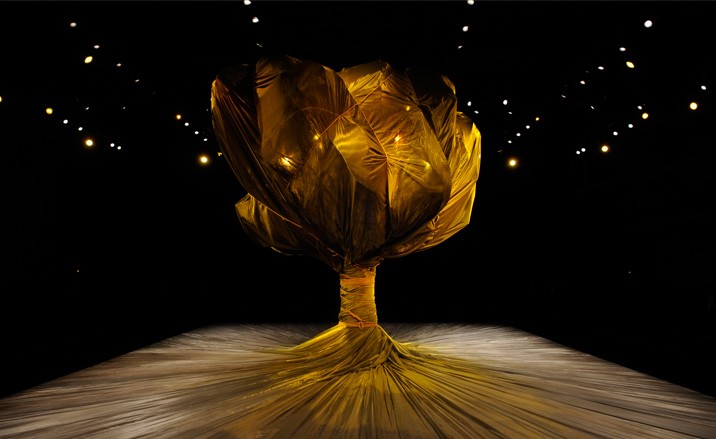“And the great elms o’erhead
Dark shadows wove on their aërial looms,
Shot through with golden thread.”
Henry Wadsworth Longfellow
Hawthorne, Stanza 2
“In crystal vapour everywhere
Blue isles of heaven laughed between
And far, in forest-deeps unseen,
The topmost elm-tree gather’d green
From draughts of balmy air”
Tennyson
Sir Launcelot and Queen Guinevere
 The cloth-wrapped tree reminded a Christo art installation
The cloth-wrapped tree reminded a Christo art installation
Let’s analyze again from where Alexander McQueen drew inspiration for his 2008-2009 Autumn/Winter Collection.
“I’ve got a 600-year-old elm tree in my garden and I made up this story of a girl who lives in it and comes out of the darkness to meet a prince and become a queen”, he claimed, was the seed of the narrative his collection would branch out from.
McQueen was an egghead, I mean, a true intellectual, especially when he was searching out information about a concept for any of his fashion collections and I’m certain, because of this, he was aware of the mythological and religious connections behind The Girl Who Lived in The Tree.
 John William Waterhouse, Hamadryad
John William Waterhouse, Hamadryad
Ἁμαδρυάδες (Hamadryads) according to Greek mythology are mostly female beings that live in a tree, in fact they are bonded to a particular tree. Some believe that hamadryads are the actual tree, while normal dryads are simply the entities, or spirits, of the trees. If the tree died, the hamadryad associated with it died as well. For that reason, dryads and the gods punished any mortals who harmed trees.
The first reference in literature to elms occurs in the epic poem attributed to Homer, Iliad. When Eetion, father of Andromache, is killed by Achilles during the Trojan War, the Mountain Nymphs plant elms on his tomb. Also in the Iliad, when the River Scamander, indignant at the sight of so many corpses in his water, overflows and threatens to drown Achilles, the latter grasps a branch of a great elm in an attempt to save himself.
But specifically, Deipnosophistae of Athenaeus (The Banquet of the Learned or Philosophers at Dinner) an ancient Greek text written in the early 3rd century AD, lists eight Hamadryads, the daughters of Oxylus and Hamadryas. And Ptelea is the name given to the hamadryad bonded to the Elm, a hermaphroditic tree comprising the genus Ulmus in the plant family Ulmaceae.
 Giovanni Segantini, Le Cattive Madri (The Evil Mothers), 1894
Giovanni Segantini, Le Cattive Madri (The Evil Mothers), 1894
 Arthur Rackham, Freia (a combination of Freyja and the goddess Iðunn—from Richard Wagner’s opera Der Ring des Nibelungen ), 1910.
Arthur Rackham, Freia (a combination of Freyja and the goddess Iðunn—from Richard Wagner’s opera Der Ring des Nibelungen ), 1910.
Arthur Hughes. Back from Sea, 1862. The characters of this painting are resting under a Ulmus procera


